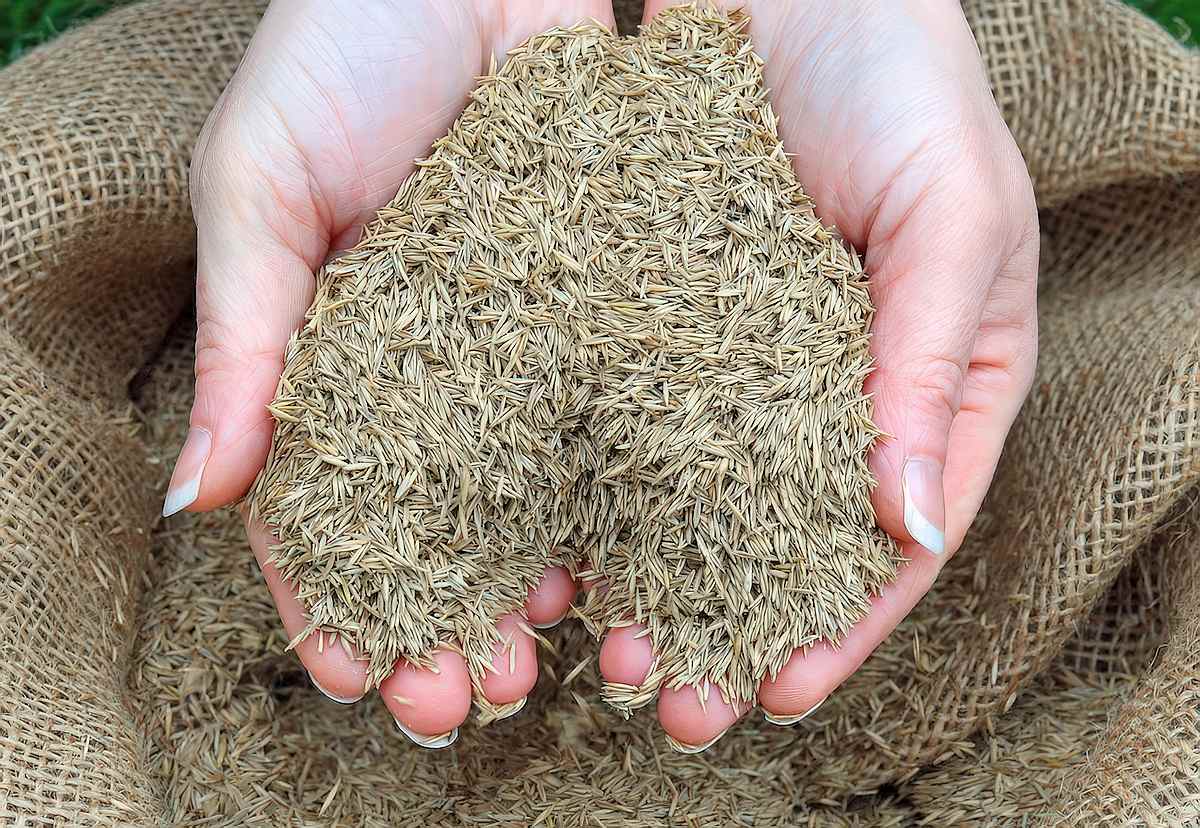Natural grass lawns are a popular feature of yards around the country, covering an area approximately equal to the size of Colorado in total.
Here in Texas, we also love our lawns but establishing them from scratch can be challenging for those of us without green fingers. There are two basic ways to develop a natural grass lawn in Texas:
- By planting seed
- By laying sod (or plugs)
If planting seed is your baby, your lawn’s appearance depends greatly on the type of grass you choose, the local climate, when you plant the seed, and how much you water and tend it.
The right timing is essential for the optimal growth and establishment of your lawn once you’ve made your choice of the best grass type.
Here’s what you need to know…
When to Plant Grass Seed in Texas?
The best time to plant grass seed in Texas depends on your precise location, the local climate, and whether you choose warm-season or cool-season grass. The ideal planting season for warm-season grass seed is generally in late spring (April/May) while cool-season grasses are best planted in the fall (November’s good).
There’s more to it than this—and we go into more detail below—but first a quick look at a grass alternative that can be introduced at any time of the year in Texas…
Don’t Want the Hassle of Planting Grass Seed?
Americans spend over $100 billion per year on lawn care, use three trillion gallons of water per year to keep lawns green, and apply 59 million pounds of pesticides to maintain their lawns.
If you want to avoid these extra costs and the drain on resources—as well as saving the time and headaches involved with planting grass seed—consider switching from real grass to artificial grass.
With synthetic lawn turf, you get:
It’s not only the Dallas Cowboys and Houston Texans who enjoy artificial turf fields in Texas. Thousands of homeowners have made the switch too—because of the many benefits of artificial grass.
SAVE TIME, MONEY & WATER WITH ARTIFICIAL GRASS
The experienced team at Artificial Grass Pros will provide a free estimate and help you make the switch. Contact us here.
Understanding the Climate Zones in Texas
One of the first considerations when planting grass seed is the climate zone you live in.
It’s no secret that Texas is the second-largest state in the country. This creates different climate zones that vary quite markedly in the growing conditions for grass.
Here’s a basic breakdown of the climatic regions of Texas:
This diverse range of temperatures and rainfall patterns makes your location a major factor when choosing the right type of grass seed and planting it for healthy germination and growth.
Most readers are likely based in one of the following areas:
Benefits of Choosing the Right Planting Time
Choosing the right planting time for grass seed (discussed in more detail below) will result not only in a lusher and more verdant lawn with greater aesthetic appeal but also the following:
Best Time to Plant Warm-Season Grasses
Warm-season grasses are planted widely around Texas—mainly Bermuda Grass, Zoysia, and Buffalo Grass (St. Augustine is only available in sod form). Bermuda Grass is one of the most popular warm-season grasses in the world.
The specific type of seed best suited to your yard depends on your precise location, conditions in your yard, and your appetite for maintenance.
Zoysia and St. Augustine are best planted from sod in spring, late summer, and fall. The best time to plant warm-season grass seed is generally between mid-winter and late spring.
The soil should be warm enough for the grass seed to germinate and grow a healthy root system—ideally 65-70 degrees Fahrenheit, with the air temperature between 70 and 95 degrees Fahrenheit.
The months when these temperature ranges apply vary between the regions of Texas but, generally speaking, as you go further north, the late spring (April or May) is a more suitable time to plant seed than in late winter.
Where winters are milder, such as in South Texas, you can plant warm-season grass seed earlier.
A tell-tale cue to plant grass seed is when the lawns in neighboring properties start to green up—usually in the spring.
Best Time to Plant Cool-Season Grasses
Cool-season grasses include Tall Fescue, Fine Fescue, Kentucky Bluegrass, and Ryegrass. These types of grasses are best suited to the north of Texas, where winters are cooler.
It’s best to plant cool-season grass in the early fall, such as September-October depending on the precise region. Later in October or early November may also be possible but the soil needs to retain some warmth.
With cool-season grasses, establishment, and healthy root growth are aided by soil temperatures between 50 and 60 degrees Fahrenheit and air temperatures between 60 and 75 degrees Fahrenheit.
The increased rainfall at this time of year may also assist healthy grass growth—and your lawn will have plenty of time to establish and settle in before the heat of spring and summer arrives.
Planting Tips for Grass Seed—beyond Choosing the Right Season
High-quality grass seed planted at the right time of year will help you establish a beautiful lawn—but seasonality is not the only consideration. For flourishing grass, here are a few other tips for planting grass seed in Texas:
Test the Soil
Ideally, before selecting and planting your grass, test the soil pH so that you can select a grass that’s suited to its acidity level. Most lawn grasses grow best in soil with a pH between 6.0 and 7.5. If it’s too low (too acidic), you can add lime and if it’s too high (alkaline), add organic matter—but call the lawn experts if you’re unsure.
Plan Your Lawn
Most grass lawns require at least 5-6 hours of sunlight to thrive. Some grasses like certain Zoysia varieties are more shade tolerant but it’s best to plan your lawn for maximum sunlight exposure.
Prepare the Soil
Loosen the top 2-3 inches of the soil and rake it before planting grass seed. Also, remove any debris, break any soil clumps up, and aerate the soil with a fork so that nutrients and water can reach the seeds.
Plant Properly
Use your hand or a mechanical spreader to disperse the seed evenly throughout your lawn so that all areas are covered. Follow the recommended seeding rates on the packaging for optimal results. Make sure that the seeds are completely covered with soil so that they are protected and can germinate.
Water Well
New grass seed requires constant moisture during germination and establishment. You will need to water lightly but frequently (two to four times daily for 5 to 10 minutes) so that the top 1.5 to 2 inches of soil remains moist—but not too much so that it becomes soggy.
Fertilize and Control Weeds
New grass benefits from extra phosphorus, which supports strong, deep roots. A starter fertilizer can be spread on the soil even before you plant the seed. As your lawn begins to establish, further fertilizing and weed control may be required.
How Much Grass Seed Do You Need?
The amount of grass seed you need to establish a new lawn depends on the type of grass and the size of the lawn. Generally speaking, you will need 4–7 pounds of seed per 1,000 square feet for a dense covering that protects from weeds.
If in doubt, try a grass seed calculator, offered by many online seed suppliers.
Overseeding Grass Lawns in Texas
Overseeding is the process of adding grass seed to an existing lawn without turning the soil. Overseeding with perennial ryegrass, for instance, is a popular way to keep Bermuda Grass lawns looking lush and verdant during the winter in Texas, when this warm-season grass can start to struggle.
If you’re overseeding a Bermuda Grass lawn with perennial ryegrass in Texas, wait until the grass is fully established for best results—about 5-8 weeks before the first frost (i.e., between late August and mid-November).
To overseed a Bermuda Grass lawn with perennial ryegrass, you’ll need about 5 to 10 pounds of seed per 1,000 square feet of lawn.
FAQs
Considering Switching to Artificial Grass?
If you’re planting new grass seed, choose the right type of grass seed for the conditions, plant it at the right time of year, and follow the planting and care tips provided.If you’re considering a low-maintenance backyard landscaping alternative to real grass, discuss your options with an artificial grass professional.



















